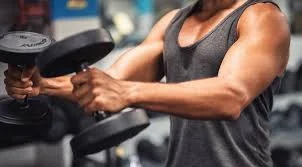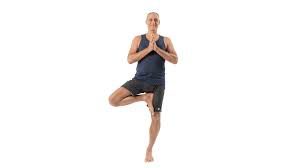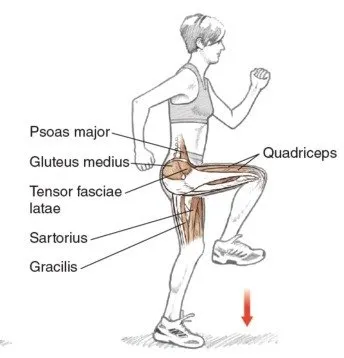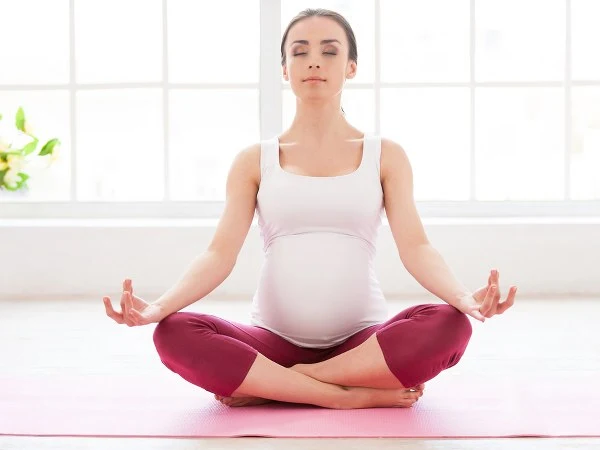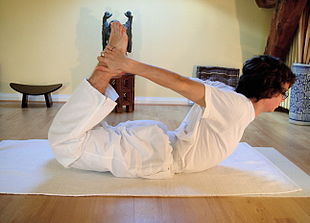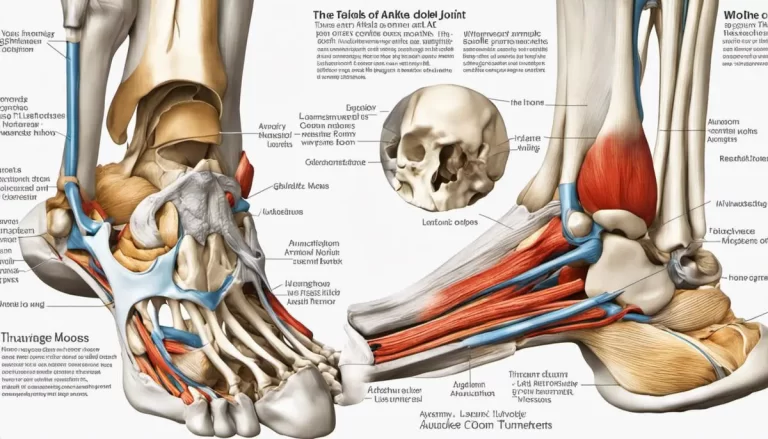Dumbbells Back Exercises to Improve Strength and Posture
Table of Contents
introduction
Spending sufficient time to work each muscle group during your workout is crucial for developing balanced strength. Additionally, having a wide variety of dumbbell back workouts to select from will help you be ready to give the whole body a little attention.
The latissimus dorsi, also known as the lats, the rhomboids, and lower trapezius, sometimes known as the traps, are back muscles that many people forget while strength training since, well, they’re in the back of the body. As a result, when individuals want to work out their upper body, they often choose to focus on training muscles that are a little simpler to see, such as their shoulders, arms, or chest.
But developing back strength is crucial, and the good news is that there are many different exercises you may take to do so, from bodyweight exercises to those that involve free weights or resistance bands. Although there are many bodyweight, barbell, and kettlebell back exercises available, here concentrate on dumbbell back exercises, covering ones that target both your upper back and lower back. Continue reading to learn more about the significance of developing back strength and to see some possibilities for exercises you may include in your next back workouts.
The first place many individuals begin is usually with exercises that test their ability to move their own bodyweight, such as pull-ups and chin-ups, as well as heavy-duty barbell activities like the barbell row or even the deadlift. That’s wonderful; these workouts might be useful for building mass and strengthening key back muscles. Placing many plates onto the bar for heavyweight pulls and bringing your head to or above the bar rep after rep both look amazing. However, you’ll be more successful getting a set of dumbbells for your back workouts if you’re looking for easy exercises that anyone can perform.
Dumbbells are a more friendly training tool for beginners since they allow you to practice with a wide variety of loads. Because of the power and form requirements, pull-ups and chin-ups can have a very high obstacle to entry for beginners, and dumbbell workouts can also be challenging for beginners for the same reasons. Instead of struggling to complete a single rep, adjusting your form, and putting yourself at risk of injury, it is better for you to be able to master the movements with weights you can handle. But not only beginners can benefit from dumbbell back exercises. Along with bodyweight and heavy dumbbell training, experienced bodybuilders may use the equipment for efficient sessions Dumbbell exercises should be a big element in any thorough back muscle training split because dumbbells provide mobility that other tools cannot.
Why is it necessary to work the back muscles?
The advantages of back exercises are numerous: One benefit of strengthening that region is that it helps posture and muscular imbalances. Our back muscles are prone to weakness, particularly if we spend much time sitting. This could increase the possibility that you’ll wind up squatting over or rounding your shoulders.
A combination of weak back muscles and prolonged sitting can also limit the range of motion in your upper back, making it challenging to move the shoulder blades efficiently. A lot of times, individuals begin to have shoulder issues from it. When they perform any type of workout that targets the ‘pushing’ muscles, such as the shoulder or chest muscles, that’s when we run into difficulties because they don’t have enough mobility and strength in the upper back. Although your rear deltoids are essentially a part of the shoulders, you should also concentrate on developing them because they are small but significant back-of-the-body muscles.
The longissimus, iliocostalis, and spinal muscles of your lower back, together known as the erector spinae, are also regarded as being a part of your core. By strengthening this region, you can stabilize your spine. That benefits walking motion, balance, joint health, and even standing posture. A good alignment relieves pressure on your joints, which can significantly reduce the risk of injury.
Gains from back exercises are substantial. Alignment and stabilization of the spine will benefit from a strong back. This will enable the remainder of the body to carry out daily tasks and workouts with support and energy. For example, your back muscles contract when you push a heavy door shut or begin a lawnmower.
A potential increase in workout efficiency has also been added to the list of advantages of back workouts. Your spinal stabilizers are constantly working to keep you in line, even if you are doing arm day. Therefore, the more accurate they are generally, the better your form will be.
How should your back muscles be worked at home?
There are many dumbbell back exercises you can perform at home to efficiently engage your back muscles, including your lats, lower traps, rhomboids, rotator cuff, and erector spinae if you have access to some equipment.
If you want to improve your back at home, you should add rows and row variations to the mix because some of these exercises use the pulling motion to target your lats and rhomboids. Other back-strengthening workouts, like those that engage your erector spinae or deep lower back muscles, concentrate on stabilization or resisting motion. Therefore, if you want to exercise your lower back or just give those muscles a little extra work, you might involve deadlifts or good morning exercises in the routine
Important information: strengthening these muscles, particularly the lower back muscles that make up your abdominals, can help prevent back discomfort, but if you already have back pain, completing back exercises might make it more harmful. If so, you might want to discuss which movements are ideal for you and which aren’t with your physician or physical therapist.
Otherwise, read on for some amazing dumbbell back exercises to attempt if you’re ready for some back-strengthening exercise choices you can perform at home. You can discover some exercise inspiration below, whether you want to design your own customized back workout, a push-pull regimen, or perhaps a full-body strength session.
Dumbbells back exercises to improve strength and posture
bent over row
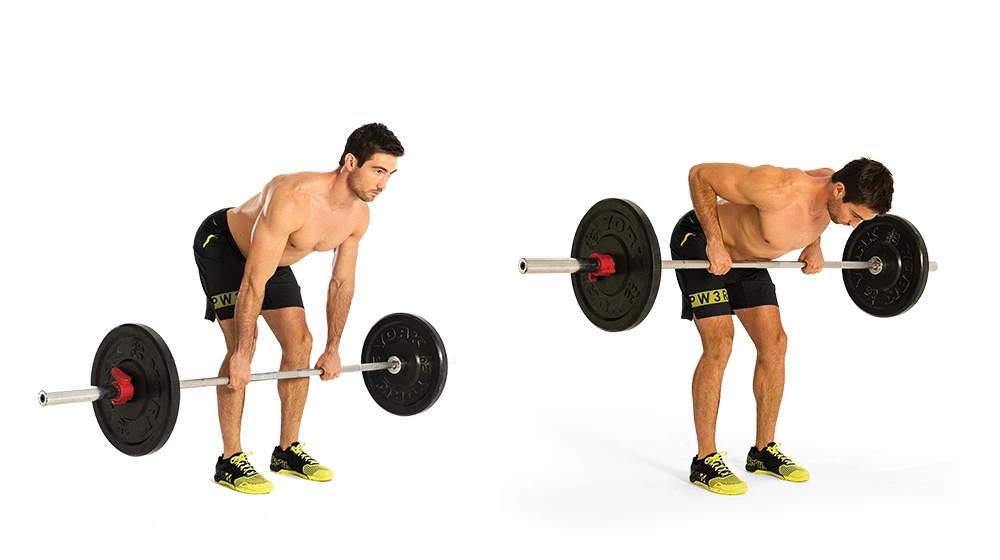
Why it rocks: Because your back is so strong, you can lift more weight with this exercise than you would with other upper-body dumbbell exercises.
grasping a dumbbell in each hand with your arms at your sides, stand with your feet hip-width separated.
Pushing your gluteal region backward, bend forward at the hips while maintaining core stability. should not rotate the shoulders while bending the legs. How far you should bend over will depend on how efficiently the hips roll and how flexible your hamstrings are.
To maintain an ideal position for your neck, look at the ground a few inches in front of your feet.
Bring the weights up toward your chest while doing a row. Squeeze your shoulder blades at the top of the exercise while maintaining the elbows near the body. As you pull the weight toward your chest, your elbows should extend beyond your back.
Extend your arms toward the floor as you gradually reduce the weights. It’s one rep. Perform 10 reps twice a day.
This classic dumbbell back exercise targets your lats, rhomboids, and biceps in addition to your core’s stabilizing muscles. It’s a wonderful exercise to incorporate into a push-pull session or other chest and back workout.
Single Arm Row
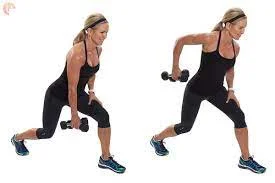
Keeping a moderate-weight dumbbell in the left hand with your arm at your side, stand with your feet hip-width separated. With your right foot, step forward approximately two feet, and place your right hand on your right quadriceps. This is where everything begins.
engaged your core, push your buttocks back, tilt forward at the hips, and bend your left knee, being careful not to round your shoulders. How far you can flex the body beyond will depend on how easily the hips move and how relaxed your hamstrings are. To maintain a comfortable position for your neck, look at the ground a few inches in front of your feet.
Maintaining a tight grip on the weight while pulling it up toward your chest, squeeze your shoulder blade at the top of the exercise. As you pull the weight toward your chest, your elbow should extend past your back.
By extending your arms toward the ground, gradually lessen the weight. It’s one rep. Perform 10 reps twice a day.
This is yet another component of any effective upper-body exercise. While your lats and rhomboids will certainly be active in this position, your core must also contract in order to maintain your balance.
Bench-Supported Single-Arm Row
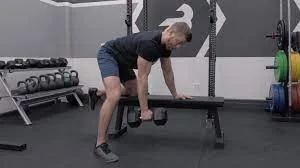
Standing in a staggered posture with your feet hip-width apart in front of a bench or chair, trunk, or other solid elevated surface. Your right arm should be by your side as you hold a dumbbell in that hand.
Keep your core engaged as you push your butt back, tilt forward at the hips, maintain a mild bend in both knees and watch out for rounding your shoulders. How far you bend the knee will depend on how skillfully the hips move and how loose your hamstrings are. With your arm straight, place your left palm on the bench.
To maintain a comfortable position for your neck, look at the ground a few inches in front of your feet. This is where everything begins.
In order to engage your back muscles, lift the weight toward your chest while keeping your elbow close to your body. Press your shoulder blade at the elevation of the movement.
To get back to the initial position, gradually drop the weight by extending your arm toward the ground. Make sure your non-working shoulder maintains a level as you drop the weight. It’s one rep. perform 10 to 15 reps, two times a day
Your lats, rhomboids, and biceps get a great workout from this exercise. Stabilizing is a little bit easier because your hand is helping to stabilize your body.
underhand row
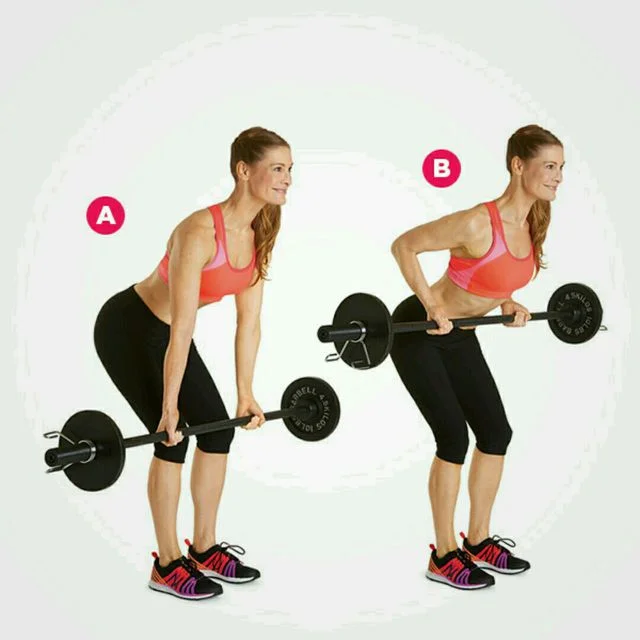
With the arms at your sides and your palms facing upwards, grasp a dumbbell in each hand while standing with your feet hip-width apart.
Pushing your buttocks back, bend forward at the hips while maintaining core stability. not rotate the shoulders while flexing the legs. How far the distance of the bend will depend on how easily the hips move and how flexible your hamstrings are.
To maintain a comfortable position for your neck, look at the ground a few inches in front of your feet.
Bring the weights up toward your chest while doing a row. Squeeze your shoulder blades at the top of the exercise while maintaining your elbows close to your body. Make sure your elbows extend past your back as you carry out the weight toward the chest
Gradually lower the weights by extending your arms toward the floor. That’s 1 rep. Execute 10 reps, two times a day
This rowing deviation hits your lattisimus dorsi and biceps more than the traditional row does.
Single-arm row in plank
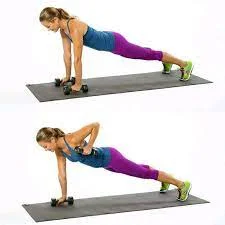
Standing with your feet hip-width apart and one dumbbell in your left hand, face a bench, solid box or step, or a chair.
Put your right palm flat on the bench as you lower your upper body toward it. Directly beneath your shoulder, your palm should be.
Place your toes smoothly on the ground and lift your heels off the floor as you extend your legs straight behind you. Instead of doing a single arm row in a plank raised on a bench, you can execute it on the ground to make it easier for the beginner.
Keep your back flat and straight by bracing your core muscles. Preserve watching down at the bench with the eyes. Your body will be angled just a bit. This is where everything begins.
Lift the weight toward the left side of the chest while doing a row, maintaining your elbow close to your body and contracting your shoulder blades at the top of the exercise.
Reverse the motion gradually to the beginning position. Complete all of your reps on one side before changing to the other side.10 reps, two times in day
Your stabilizing core muscles must work overtime while you are in the plank position to prevent tilting.
An alternative bent-over row
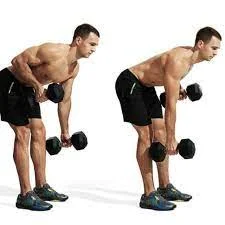
Why it rocks: this exercise makes use of your body’s strong back, which enables you to lift harder than you would with other upper-body dumbbell exercises.
What it performs: this move works your lats as well as your rear deltoids and mid to lower traps.
How to execute: Start by standing with your palms facing in and a dumbbell in each hand.
the body should be nearly parallel to the floor (or just above) while you bend forward with slightly bent knees. The abdominal muscles will start to work as you push your buttocks back and lower the chest.
Exhale and start the exercise by pulling the shoulder blades back while pressing the elbows behind the body. the thumb should point in the direction of your ribs.
Till the elbows are at the midline, pull the dumbbells toward your body.
As you gradually drop the weights back to their initial position, breathe in. it is one rep. or two times every day, do 10 to 15 repetitions.
Dog-Bird Row
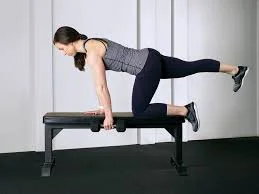
While seated on a bench, hold a dumbbell in your right hand and adopt the bird dog position. Your right knee and left hand ought to be flat on the bench. Make sure your hand is placed beneath your shoulder and your knee is stacked below your hip. Lean back and extend your left leg. Throughout the course of the set, you will remain in dog bird row.
Bringing the dumbbell up toward your chest while keeping your elbows close to your body and tightening your shoulder blades at the top of the movement is how you row a dumbbell. As you pull the weight toward the center of your body, your elbows should extend midline of your back. Extend your arms toward the floor as you gradually reduce the weights. It’s one rep. complete 10 reps twice daily.
Extend your arms toward the floor as you gradually reduce the weights. It’s one rep. Switch sides and continue once you’ve completed all of your reps.
This workout challenges your core while also working your back muscles because you’re holding the bird-dog stance while completing the rowing motion. Without a doubt, you should use less weight than you typically do for rows.
Renegade Row
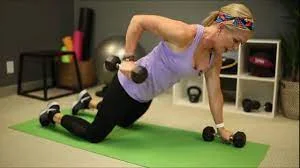
Start in a kneeling position with your legs twisted behind you wider than hip-width apart it will aid with stability, hands shoulder-width apart, shoulders stacked precisely above your wrists, and your core and glutes engaged. This is where everything begins.
To perform a row, pull your right elbow back while maintaining it close to your body and raising the dumbbell toward your chest. To stop your hips from swaying, keep your abs and butt stiff.
To return to the beginning, lower the weight. Similarly, move your left arm. That is one rep. 10 reps should be done twice a day.
You remove one point of direct contact with the ground when you pick up your arm to row, so your core has to work more to keep you upright.
Triceps Kickback in a high plank
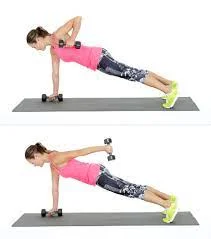
Start in a high plank position with your legs extended behind you wider than hip-width apart (it will aid with stability), hands shoulder-width apart, shoulders stacked precisely above your wrists, and your core and glutes engaged. This is where everything begins.
To perform a row, pull your right elbow back while maintaining it close to your body and raising the dumbbell toward your chest. To stop your hips from swaying, keep your abs and buttocks stiff
At the top of the row, extend the arm and straighten the arm behind you. This is the kickback component of the action.
Change the movement, then reduce the weight to the initial position. Repeat with the left arm. That is one rep. Execute eight to ten reps, two times in the day
This is a demanding core exercise that also performs your back thanks to the row and your triceps the muscles along the back of your upper arm with the kickback.
Pullover
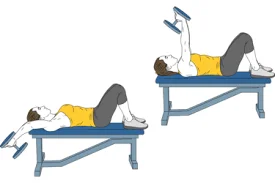
Place a dumbbell in front of you as you lie on your side on a mat. Turn flat on your back, take the weight in both hands, and bring it close to your chest. maintain hip distance between your feet.
Hold the dumbbell firmly in each hand at the ends. If your dumbbell is bigger, holding it vertically with both hands wrapped surround one end might feel safer. Maintain your arms straight as you raise it straight up beyond your chest.
Lift the dumbbell slowly above your head, then touch the floor with it lightly.
Utilizing your core to help you move the weight, return it to where you started. Perform this one rep, 10 reps total, twice daily.
This exercise for vertical pulling specifically works the huge lattisimus dorsi muscles. Dumbbell vertical pulls are frequently challenging to identify, so save this exercise for a successful dumbbell session
Reverse fly
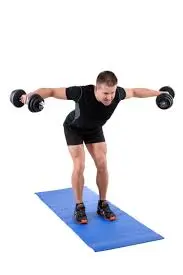
Carrying a weight in each of your hands with your arms at your sides, palms facing inward, and elbows slightly bent, stand with your feet hip-width separated.
Your back should not be lower than level to the floor, so with your core attached, bend forward at the hips, push your buttocks back, and somewhat flex your knees. You might not be capable of bending down so low depending on how easily your hips move and how flexible your hamstrings are. To maintain a comfortable position for your neck, look at the ground a few inches in front of your feet.
Lift your arms out to the sides until they are parallel to your shoulders while maintaining a flat back, a firm core, and bent elbows. After a brief pause, bring your arms back down to where they were before. That is one rep. Execute eight to ten reps, two times a day
Your rear deltoids, a little muscle in the back of your shoulder that is important for posture and injury avoidance, are worked during this exercise.
Single-Arm Rear-Delt Raise on a Quadruped
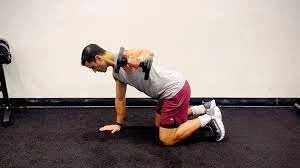
Begin on all fours on a mat, putting your palms and knees under the shoulders and the hips. Your right hand should be keeping a dumbbell.
Feel the strain in your right shoulder as you raise it to the side. Attempt not to turn to the side, brace your core, and maintain a straight back.
Dumbbell back down to the floor. It’s one rep. Execute 10 reps, two times in the day
This exercise demands your core to engage in order to keep you stable in addition to training the little muscles on the back of your shoulders.
Romanian Deadlift
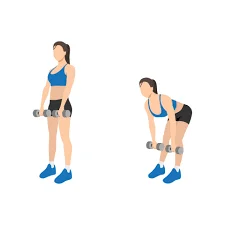
Knees slightly bent, feet hip-width apart, stand. At the thighs, carry a dumbbell in individual hand.
twist at your hips while bending your knees just a slight. Keep your back flat and push your butt all the way back. The weights should be at the tibia bone and the body should be practically similar to the floor.
give force via the heels to stand up straight while preserving strong core muscles. As you pull, keep the weights towards your shins.
At the top, pause and squeeze your buttocks. That is one rep. Execute 10 reps, two times in the day
The deadlift, which works your hamstrings and glutes, is often programmed on leg days, but it also requires the activation of your lower back’s stabilizing muscles as well as your larger upper back muscles. appropriate deadlift form is necessary to check that you do not overstress the back
Kickstand Deadlift
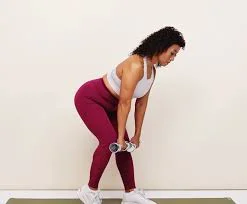
Carrying a dumbbell in each hand, take a hip-width stance.
To initiate a staggered stance, position one foot a foot’s length behind the other, with the heel lifted. Your front leg will be placed to utilize.
To carry the body downward, bend at the hips. Maintain the back flat while giving force to your buttocks far back. the body should be nearly perpendicular to the ground.
Push through your front heel to stand up straight while maintaining a strong core. As you draw up, keep the weights towards your shins.
At the elevation, pause and press the buttocks. Perform 10 reps, twice a day, starting with 1 rep.
This exercise, known as a unilateral deadlift, calls for more core involvement than the bilateral deadlift because your rear leg is on the ground for balance.
Single leg Deadlift
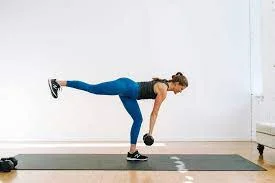
Holding a dumbbell in front of your legs with each hand, stand with your feet together. This is where everything begins.
Change your weight to your left leg, elevate your right leg straight behind you, hinge at the hips to bring your torso parallel to the floor, and go down your weight toward the floor all while maintaining a tiny bend in your left knee.
Hold your back straight. Your body and right leg should be practically parallel to the floor at the bottom of the exercise, with your weight only a few inches off the ground. if the hamstring is tight, you might not be capable of raising the legs as high.
Carry the weight back up to the beginning position while maintaining a tight core by pushing via your left heel to stand up straight. Attempt to maintain the majority of your weight on your left foot as you carry the right leg back down so it meets your left foot.
Tighten your butt while you pause there. It’s one rep. Finish all of your reps on one side before switching.10 reps, two or three times a day
If maintaining balance makes this maneuver too difficult, you might try holding a dumbbell in one hand while softly bracing a wall or other significant object with your other hand
Good morning with dumbbell
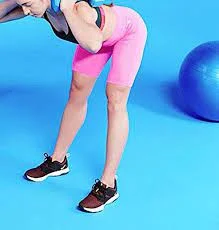
grip one dumbbell horizontally at your chest while standing with your feet hip-width separated. Crossing the arms to grip the weight more firmly. This is where everything begins.
Maintaining a slight bend in the knees, tilt your body forward while pushing your buttocks back and hinging forward at the hips. When your body is just slightly above perpendicular to the ground, stop.
As you bring the body back up and return to the beginning posture, thrust your hips forward. At the end of the exercise, tighten your glutes. That is one rep. ten to fifteen repetitions, two to three times in day.
Your lower back muscles, hamstrings, and glutes are all worked out by the hip bend exercise.
Rear Delt Raise With One Arm
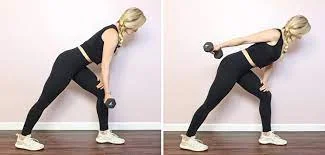
Lean forward at the hips while holding a dumbbell in one hand and placing the other hand on a firm surface.
Your hand should be pointing forward as you let the dumbbell dangle straight down from your shoulder.
Raise your arm straight back until it is parallel to your body without moving your body.
After staying, move comfortably back to your beginning position. A rep is one. Execute 10–15 repetitions, two–three times each day.
muscle worked: posterior deltoids or shoulder muscles, upper back muscles
Bent over fly
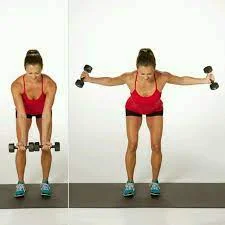
Standing with your feet hip-width separated and your knees bent, grasp a pair of dumbbells.
With the palms watching the body, let your arms extend straight down from your shoulders as you lean forward at the hips.
Hold your shoulder blades together as you lift your arms out to the sides.
Control at shoulder height and move back to the starting. A rep is one. execute 10 reps, three in the day
muscle worked: deltoid
Alternating reverse fly

Standing with your feet hip-width separated and your knees bent, grasp a pair of dumbbells.
With your palms touching your body, let your arms extend straight down from your shoulders as you lean forward at the hips.
Squeeze your shoulder blades together as you elevate one arm out to the side.
At the top, pause, then slowly go down yourself. One rep, execute10 reps, three times a day
muscle worked: supraspinatus, infraspinatus, teres minor, subscapularis, upper back muscles
Zottman Curl
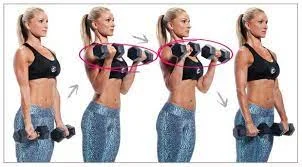
target muscles: biceps and forearms
Why it works: This bicep curl deviation assists in building forearm and grip strength, which is great for those who work with their hands regularly. People who work desk jobs, cook, climb mountains, or work as nail technicians all benefit.
How to execute: Begin by standing straight and spaced hip-distance apart while grasping dumbbells at the sides with hands facing the thighs.
With the palms facing up, twist both dumbbells up toward the shoulders.
Turn the dumbbells so that their palms are facing forward at the top.
After that, bring your arms back down to your thighs, palms facing down.
Dumbbells should be rotated downward until their palms are once more facing forward. It’s one rep. three times a day, execute 10 reps.
Trainer advice: When performing this exercise, maintain a strong grip and neutral wrists.
prone Y Extension with dumbbells
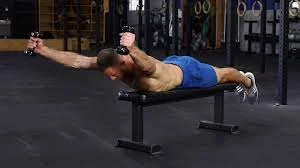
On a bench or exercise ball, lie on your belly with your palms facing in and a dumbbell in each hand.
Place your arms out in front of you in the form of a Y letter, fully expanded.
As you raise your arms as high as you can above your head, engage your core and squeeze your shoulder blades together.
At the top, stay for three to five seconds.
come back to the normal position progressively.
five more times.
muscle worked: supraspinatus, upper and lower trapezius,
Seated T spine opener
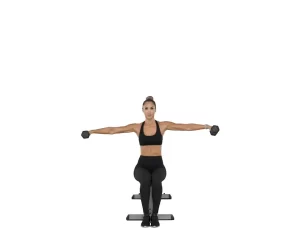
Begin by sitting on a bench with your elbows nearly touching and your hands behind your neck. Starting from your upper back, elevate your chest and elbows in the direction of the top. Avoid bending at the lower back.
It’s one rep, then. Perform three sets of 8–10 reps.
Superman with dumbbells
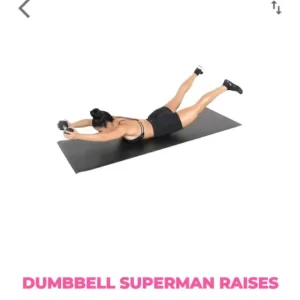
Lie on your stomach with your arms extended back alongside your body, holding a dumbbell in each hand with the palms facing up.
Pull in your abs, tighten your core, and lift your legs off the ground while squeezing your glutes. To maintain your neck in the correct alignment while you press your back to elevate your upper body, slowly lift your head and look a few inches in front of the floor.
Next, raise your arms toward the roof. At the top, tighten your shoulder blades together and hold for a second before lowering yourself back down.
muscle worked: front abdominal muscles, rectus abdominis, transverse abdominis, internal and external obliques, lower and upper back muscles, and other surrounding muscles
standing row
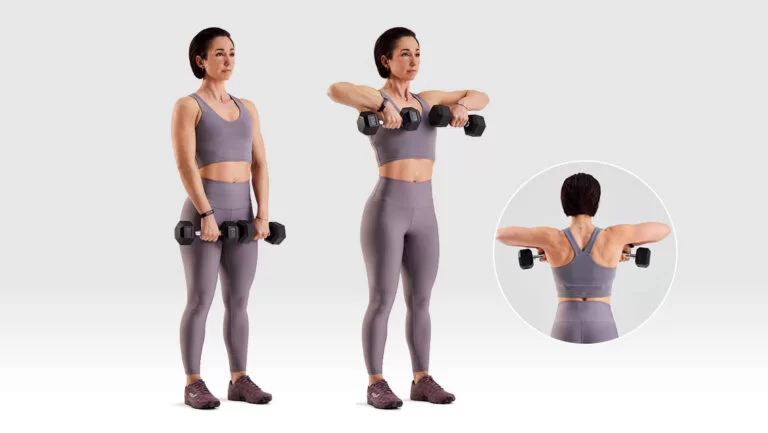
With your feet hip-width apart and your back straight, hold a dumbbell in each hand and carry it with the palms facing you.
Lift the dumbbells toward your chin by raising the elbows to the top while keeping your chest raised and your core engaged. Drop to your starting position.
Ten repetitions should be done.
muscle worked: side deltoids, trapezius
The Benefits of Dumbbell Back Exercises
- Boost your posture: strengthening your back reduces injury risk by enhancing posture. You’re going to get hurt if you begin to walk in a manner that isn’t anatomically correct, Consider maintaining a spine that is erect, a chin equal to the floor, rolled-back shoulders, and even hips.
- Avoid harm: the back is the body’s center of gravity and should help avoid shoulder, hip, and neck pain. if you don’t have a strong back, you will be hurt. In addition, studies indicate that strengthening your back muscles can help lessen back pain.
- secure stability: Although the anatomy of your back is complicated, the muscles that surround your spine are crucial for stability and strength. All the different muscle fibers surrounding your spine become stronger and tighter when you exercise the back, so they aren’t loose. By building up the muscles that surround your spine, you can lessen chronic back pain and ease the physical strain of daily activities like picking up children or carrying groceries.
- more joint-friendly: Barbells lock you into a specific range of motion and grip, whereas dumbbells do not. It is easier on the wrist, elbow, and shoulder joints because there is more movement mobility and you can lift with a neutral grasp.
- Strength Imbalances: If there are any imbalances between the sides, training unilaterally, such as with single-arm dumbbell lines, will help to strengthen them. Because both sides of the body are engaged simultaneously when using dumbbells and grip bars, one side can easily overlook the other.
- Better Muscle Development: When you hold two dumbbells, either side of your body still generates separate force to hold the weights constant. When you use two dumbbells regularly, your weaker side can overtake the stronger side, which will improve the muscle development on that side. Additionally, using dumbbells will usually give you a wide range of motion, allowing you to stretch and contract your muscles to their fullest potential. Another crucial component of strength and muscular development.
- Easier to Use: Barbells need the addition and removal of plates, and frequently necessitate the use of other pieces of apparatus, such as a bench for exercises like the bench press. Dumbbells are more suitable to utilize, set up, and pack away.
With a pair of dumbbells, you can prepare the vital muscle groups that guard your shoulder blades and improve your posture while also developing the back power you’ll ultimately need to master chin-ups and pull-ups.
This is partly because using dumbbells allows you to perform the row, which is possibly the most important back workout there is. The exercise works your lats, midback stabilizers, and rhomboids all at once, and it’s a crucial dumbbell exercise that balances life’s stresses.
All of that is conducted by containing dumbbell back exercises in your habits, which also assists in growing the strength and back muscle you require to count thickness between your shoulder blades as well as all over your upper back. This is especially true if you start engaging in back workouts using heavier dumbbells, like farmer’s carries, strong dumbbell rows, and inclination rows.
Additionally, some exercisers may find it easier to use dumbbells than other gym equipment, such as barbells or exercise machines; many people are much more likely to have access to a set of dumbbells than expensive plates and machines that call for gym memberships.
Advice and Safety Measures
There are specific crucial suggestions and safety measures you should keep in mind before beginning these exercises. Exercise is good for your health, but if done properly and with the right gear, it can be safe.
Warm-up: Get started with a little warm-up. This can involve doing a little cardio or even a fast walk or jog in place. It’s critical to warm up your muscles and get your blood flowing before beginning an exercise program.
begin with smaller weights: Begin with lesser weights if you’re unfamiliar with dumbbell workouts or haven’t worked out in an extended period of time. Elevate the weight progressively as you gain strength.
Form and technique: Concentrate on maintaining proper form and technique rather than lifting huge weights. Injuries and ineffective workouts might result from the incorrect technique.
Observe the body: If you experience any kind of pain or discomfort while exercising, stop right away. To prevent damage, it’s crucial to pay attention to your body’s warnings. Including stretching Stretch out for a while after your workout. This will promote recuperation and avoid muscle stiffness.
The Importance of Consistency
Last, but not least, it’s important to remember that consistency is critical with exercise in general. You can strengthen your back and posture by including these exercises in your training regimen. Although it won’t happen right away, constant effort will probably start to show results.
Keep in mind that practically every action you make throughout the day relies on your back. Spending a little time each day building up these muscles will raise your general fitness while also enhancing your posture and easing discomfort.
Takeaway
Your posture will improve, your neck and shoulder pain will go down, and your back pain will go away if you build up your upper back strength.
Additionally, having the proper posture enhances your attractiveness. By maintaining the strength of these muscles with dumbbell back exercises, you may avoid placing undue strain on the spine, which can cause harm, discomfort, and injury.
Dumbbells are the ideal piece of equipment to use in your back workout because they are all you need to work your back. There are exercises for everyone, whether they want to work their upper back, lower back, or both at once.
FAQS
Dumbbell rows are a fantastic workout to perform with correct posture. This easy exercise strengthens the lattisimus dorsi and trapezius, two essential postural muscle groups that oppose the forces of chest slouching.
Updating poor posture demands both stretching and strengthening of the muscles in the upper back, chest, and core.
Since poor posture limits the utilization of phasic fibers for aid, it gradually causes deeper helping muscles to atrophy from insufficient usage. Unused, weak muscles have a tendency to contract, which can cause compression of the vertebrae in the spine and a subsequent loss of posture.
Consider gently rotating your head front to back, side to side, or in little circles. Every day, lie flat on the ground for two to three minutes. Without using any cushions or other supports, relax while executing this exercise. This will improve your posture by allowing your body to return to its normal position.
The neck and small upper back muscles that assist in pulling the shoulders back may become weak and the chest muscles may shorten as a result of having the same position repeatedly. The primary back and neck muscles, like the trapezius and rhomboids, continue to work harder as a consequence, and as a result, they become stiff and irritated.
The deadlift is still the finest exercise for the back since it engages every muscle in your posterior chain and strengthens your core and lattisimus dorsi at the same time. Moving heavier is advised here, and as your attractions get stronger, you’ll observe how much more defined your back receives. Don’t skip deadlift day.
Along with other muscle groups, the hamstrings which contain semitendinosus, semimembranosus, rectus femoris, and large back muscles are crucial for preserving good posture. These postural muscles, along with others, control them from pushing forward when they are performing properly. Our postural muscles also support them balanced while we’re moving.
Keys for good posture: Stand tall and straight, shoulders back.
Maintain your head level and in alignment with your body.
Draw in your stomach.
A shoulder’s width should be maintained between your feet.
Avoid letting your knees lock.
Place the majority of your weight on your feet’s soles.
You should have space for your hands to hang at your sides.
Tight pectoralis and rounded shoulders are two of the six indicators of bad posture. A common sign of poor posture in office workers is their abnormally rounded shoulders and tight chest muscles.
moving the head forward.
Back hunched (kyphosis).
persistent headaches.
pelvis tilted.
neck and back ache.
References
Full Citation: K. (2023, May 21). 10 Back-Strengthening Dumbbell Exercises for Better Posture. Dr. Body Gadget. https://drbodygadget.com/dumbbell-back-exercises-workout/
S. (2022, December 6). 5 Dumbbell Back Exercises for Improved Posture. Sportskeeda. https://www.sportskeeda.com/health-and-fitness/5-dumbbell-back-exercises-improved-posture
Breitowich, A. (2023, February 6). 11 Best Dumbbell Back Exercises From A Trainer You Can Do Anywhere. Women’s Health. https://www.womenshealthmag.com/fitness/g28553492/dumbbell-back-exercises/
CPT, C. S., & RYT, E. M. C. (2023, September 1). 15 Dumbbell Back Exercises to Help You Build Strength and Improve Posture. SELF. https://www.self.com/gallery/dumbbell-back-workout
Tirgar, P. (2023, June 30). Dumbbell Back Exercises to Improve Your Strength and Posture. Mobile Physiotherapy Clinic. https://mobilephysiotherapyclinic.in/dumbbell-back-exercises-to-improve-your-strength-and-posture/

